Zihao Deng
MMSearch-R1: Incentivizing LMMs to Search
Jun 25, 2025Abstract:Robust deployment of large multimodal models (LMMs) in real-world scenarios requires access to external knowledge sources, given the complexity and dynamic nature of real-world information. Existing approaches such as retrieval-augmented generation (RAG) and prompt engineered search agents rely on rigid pipelines, often leading to inefficient or excessive search behaviors. We present MMSearch-R1, the first end-to-end reinforcement learning framework that enables LMMs to perform on-demand, multi-turn search in real-world Internet environments. Our framework integrates both image and text search tools, allowing the model to reason about when and how to invoke them guided by an outcome-based reward with a search penalty. To support training, We collect a multimodal search VQA dataset through a semi-automated pipeline that covers diverse visual and textual knowledge needs and curate a search-balanced subset with both search-required and search-free samples, which proves essential for shaping efficient and on-demand search behavior. Extensive experiments on knowledge-intensive and info-seeking VQA tasks show that our model not only outperforms RAG-based baselines of the same model size, but also matches the performance of a larger RAG-based model while reducing search calls by over 30%. We further analyze key empirical findings to offer actionable insights for advancing research in multimodal search.
Towards Safe and Robust Autonomous Vehicle Platooning: A Self-Organizing Cooperative Control Framework
Aug 18, 2024



Abstract:In the emerging hybrid traffic flow environment, which includes both human-driven vehicles (HDVs) and autonomous vehicles (AVs), ensuring safe and robust decision-making and control is crucial for the effective operation of autonomous vehicle platooning. Current systems for cooperative adaptive cruise control and lane changing are inadequate in responding to real-world emergency situations, limiting the potential of autonomous vehicle platooning technology. To address the aforementioned challenges, we propose a Twin-World Safety-Enhanced Data-Model-Knowledge Hybrid-Driven autonomous vehicle platooning Cooperative Control Framework. Within this framework, a deep reinforcement learning formation decision model integrating traffic priors is designed, and a twin-world deduction model based on safety priority judgment is proposed. Subsequently, an optimal control-based multi-scenario decision-control right adaptive switching mechanism is designed to achieve adaptive switching between data-driven and model-driven methods. Through simulation experiments and hardware-in-loop tests, our algorithm has demonstrated excellent performance in terms of safety, robustness, and flexibility. A detailed account of the validation results for the model can be found in \url{https://perfectxu88.github.io/towardssafeandrobust.github.io/}.
Multi-Robot Collaborative Navigation with Formation Adaptation
Apr 02, 2024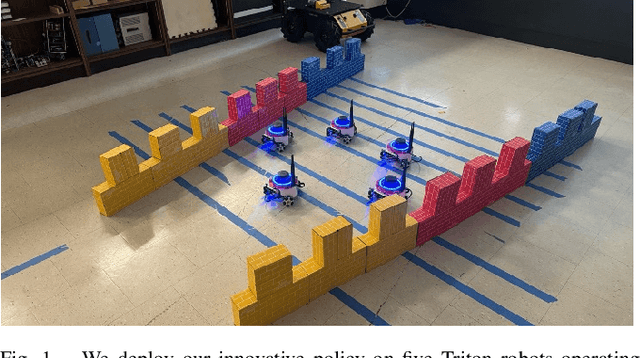

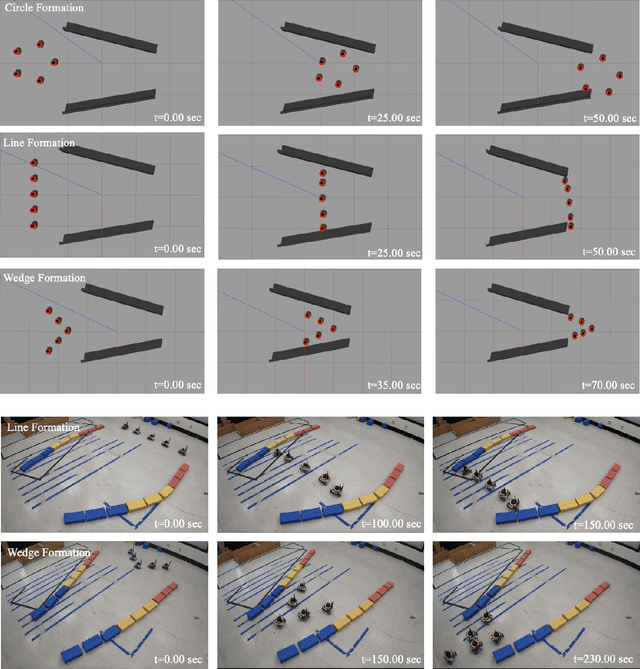

Abstract:Multi-robot collaborative navigation is an essential ability where teamwork and synchronization are keys. In complex and uncertain environments, adaptive formation is vital, as rigid formations prove to be inadequate. The ability of robots to dynamically adjust their formation enables navigation through unpredictable spaces, maintaining cohesion, and effectively responding to environmental challenges. In this paper, we introduce a novel approach that uses bi-level learning framework. Specifically, we use graph learning at a high level for group coordination and reinforcement learning for individual navigation. We innovate by integrating a spring-damper model within the reinforcement learning reward mechanism, addressing the rigidity of traditional formation control methods. During execution, our approach enables a team of robots to successfully navigate challenging environments, maintain a desired formation shape, and dynamically adjust their formation scale based on environmental information. We conduct extensive experiments to evaluate our approach across three distinct formation scenarios in multi-robot navigation: circle, line, and wedge. Experimental results show that our approach achieves promising results and scalability on multi-robot navigation with formation adaptation.
Enhancing Cross-Category Learning in Recommendation Systems with Multi-Layer Embedding Training
Sep 27, 2023

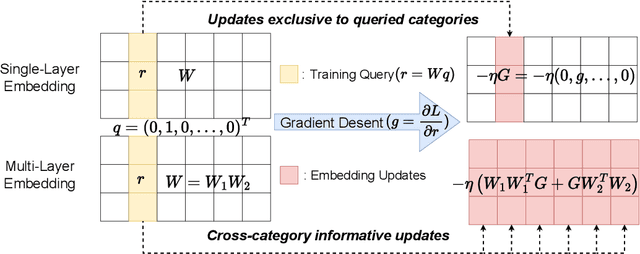

Abstract:Modern DNN-based recommendation systems rely on training-derived embeddings of sparse features. Input sparsity makes obtaining high-quality embeddings for rarely-occurring categories harder as their representations are updated infrequently. We demonstrate a training-time technique to produce superior embeddings via effective cross-category learning and theoretically explain its surprising effectiveness. The scheme, termed the multi-layer embeddings training (MLET), trains embeddings using factorization of the embedding layer, with an inner dimension higher than the target embedding dimension. For inference efficiency, MLET converts the trained two-layer embedding into a single-layer one thus keeping inference-time model size unchanged. Empirical superiority of MLET is puzzling as its search space is not larger than that of the single-layer embedding. The strong dependence of MLET on the inner dimension is even more surprising. We develop a theory that explains both of these behaviors by showing that MLET creates an adaptive update mechanism modulated by the singular vectors of embeddings. When tested on multiple state-of-the-art recommendation models for click-through rate (CTR) prediction tasks, MLET consistently produces better models, especially for rare items. At constant model quality, MLET allows embedding dimension, and model size, reduction by up to 16x, and 5.8x on average, across the models.
MusiLingo: Bridging Music and Text with Pre-trained Language Models for Music Captioning and Query Response
Sep 15, 2023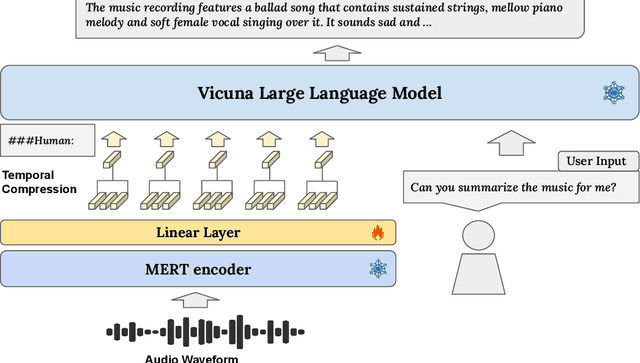
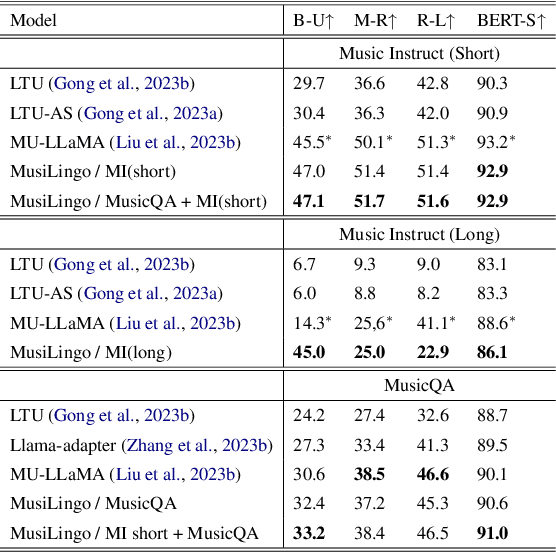
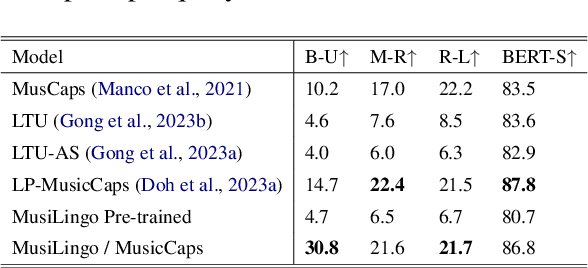
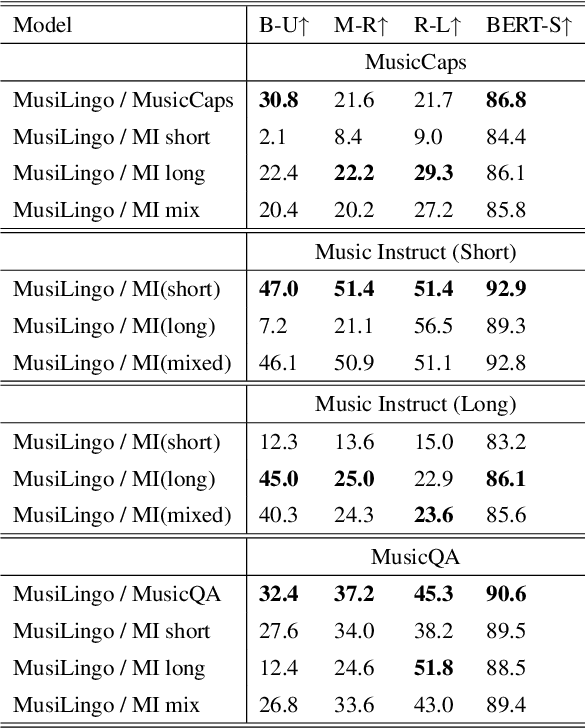
Abstract:Large Language Models (LLMs) have shown immense potential in multimodal applications, yet the convergence of textual and musical domains remains relatively unexplored. To address this gap, we present MusiLingo, a novel system for music caption generation and music-related query responses. MusiLingo employs a single projection layer to align music representations from the pre-trained frozen music audio model MERT with the frozen LLaMA language model, bridging the gap between music audio and textual contexts. We train it on an extensive music caption dataset and fine-tune it with instructional data. Due to the scarcity of high-quality music Q&A datasets, we created the MusicInstruct (MI) dataset from MusicCaps, tailored for open-ended music inquiries. Empirical evaluations demonstrate its competitive performance in generating music captions and composing music-related Q&A pairs. Our introduced dataset enables notable advancements beyond previous ones.
Mixed-Precision Quantization with Cross-Layer Dependencies
Jul 11, 2023Abstract:Quantization is commonly used to compress and accelerate deep neural networks. Quantization assigning the same bit-width to all layers leads to large accuracy degradation at low precision and is wasteful at high precision settings. Mixed-precision quantization (MPQ) assigns varied bit-widths to layers to optimize the accuracy-efficiency trade-off. Existing methods simplify the MPQ problem by assuming that quantization errors at different layers act independently. We show that this assumption does not reflect the true behavior of quantized deep neural networks. We propose the first MPQ algorithm that captures the cross-layer dependency of quantization error. Our algorithm (CLADO) enables a fast approximation of pairwise cross-layer error terms by solving linear equations that require only forward evaluations of the network on a small amount of data. Decisions on layerwise bit-width assignments are then determined by optimizing a new MPQ formulation dependent on these cross-layer quantization errors via the Integer Quadratic Program (IQP), which can be solved within seconds. We conduct experiments on multiple networks on the Imagenet dataset and demonstrate an improvement, in top-1 classification accuracy, of up to 27% over uniform precision quantization, and up to 15% over existing MPQ methods.
Factorized Contrastive Learning: Going Beyond Multi-view Redundancy
Jun 08, 2023Abstract:In a wide range of multimodal tasks, contrastive learning has become a particularly appealing approach since it can successfully learn representations from abundant unlabeled data with only pairing information (e.g., image-caption or video-audio pairs). Underpinning these approaches is the assumption of multi-view redundancy - that shared information between modalities is necessary and sufficient for downstream tasks. However, in many real-world settings, task-relevant information is also contained in modality-unique regions: information that is only present in one modality but still relevant to the task. How can we learn self-supervised multimodal representations to capture both shared and unique information relevant to downstream tasks? This paper proposes FactorCL, a new multimodal representation learning method to go beyond multi-view redundancy. FactorCL is built from three new contributions: (1) factorizing task-relevant information into shared and unique representations, (2) capturing task-relevant information via maximizing MI lower bounds and removing task-irrelevant information via minimizing MI upper bounds, and (3) multimodal data augmentations to approximate task relevance without labels. On large-scale real-world datasets, FactorCL captures both shared and unique information and achieves state-of-the-art results on six benchmarks.
Quantifying & Modeling Feature Interactions: An Information Decomposition Framework
Feb 23, 2023Abstract:The recent explosion of interest in multimodal applications has resulted in a wide selection of datasets and methods for representing and integrating information from different signals. Despite these empirical advances, there remain fundamental research questions: how can we quantify the nature of interactions that exist among input features? Subsequently, how can we capture these interactions using suitable data-driven methods? To answer this question, we propose an information-theoretic approach to quantify the degree of redundancy, uniqueness, and synergy across input features, which we term the PID statistics of a multimodal distribution. Using 2 newly proposed estimators that scale to high-dimensional distributions, we demonstrate their usefulness in quantifying the interactions within multimodal datasets, the nature of interactions captured by multimodal models, and principled approaches for model selection. We conduct extensive experiments on both synthetic datasets where the PID statistics are known and on large-scale multimodal benchmarks where PID estimation was previously impossible. Finally, to demonstrate the real-world applicability of our approach, we present three case studies in pathology, mood prediction, and robotic perception where our framework accurately recommends strong multimodal models for each application.
MultiViz: An Analysis Benchmark for Visualizing and Understanding Multimodal Models
Jun 30, 2022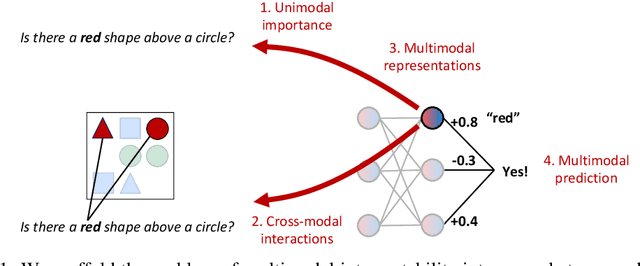



Abstract:The promise of multimodal models for real-world applications has inspired research in visualizing and understanding their internal mechanics with the end goal of empowering stakeholders to visualize model behavior, perform model debugging, and promote trust in machine learning models. However, modern multimodal models are typically black-box neural networks, which makes it challenging to understand their internal mechanics. How can we visualize the internal modeling of multimodal interactions in these models? Our paper aims to fill this gap by proposing MultiViz, a method for analyzing the behavior of multimodal models by scaffolding the problem of interpretability into 4 stages: (1) unimodal importance: how each modality contributes towards downstream modeling and prediction, (2) cross-modal interactions: how different modalities relate with each other, (3) multimodal representations: how unimodal and cross-modal interactions are represented in decision-level features, and (4) multimodal prediction: how decision-level features are composed to make a prediction. MultiViz is designed to operate on diverse modalities, models, tasks, and research areas. Through experiments on 8 trained models across 6 real-world tasks, we show that the complementary stages in MultiViz together enable users to (1) simulate model predictions, (2) assign interpretable concepts to features, (3) perform error analysis on model misclassifications, and (4) use insights from error analysis to debug models. MultiViz is publicly available, will be regularly updated with new interpretation tools and metrics, and welcomes inputs from the community.
DIME: Fine-grained Interpretations of Multimodal Models via Disentangled Local Explanations
Mar 03, 2022



Abstract:The ability for a human to understand an Artificial Intelligence (AI) model's decision-making process is critical in enabling stakeholders to visualize model behavior, perform model debugging, promote trust in AI models, and assist in collaborative human-AI decision-making. As a result, the research fields of interpretable and explainable AI have gained traction within AI communities as well as interdisciplinary scientists seeking to apply AI in their subject areas. In this paper, we focus on advancing the state-of-the-art in interpreting multimodal models - a class of machine learning methods that tackle core challenges in representing and capturing interactions between heterogeneous data sources such as images, text, audio, and time-series data. Multimodal models have proliferated numerous real-world applications across healthcare, robotics, multimedia, affective computing, and human-computer interaction. By performing model disentanglement into unimodal contributions (UC) and multimodal interactions (MI), our proposed approach, DIME, enables accurate and fine-grained analysis of multimodal models while maintaining generality across arbitrary modalities, model architectures, and tasks. Through a comprehensive suite of experiments on both synthetic and real-world multimodal tasks, we show that DIME generates accurate disentangled explanations, helps users of multimodal models gain a deeper understanding of model behavior, and presents a step towards debugging and improving these models for real-world deployment. Code for our experiments can be found at https://github.com/lvyiwei1/DIME.
 Add to Chrome
Add to Chrome Add to Firefox
Add to Firefox Add to Edge
Add to Edge